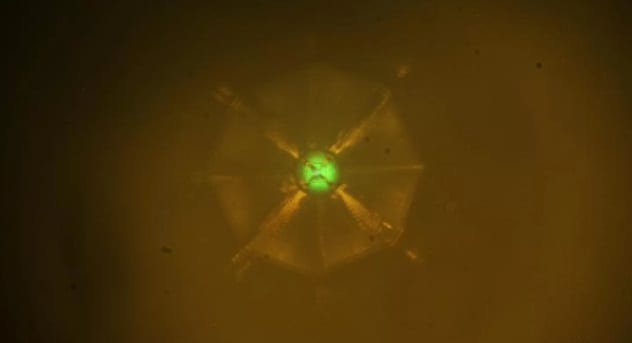 Mysteries
Mysteries  Mysteries
Mysteries  History
History 10 Surprising Stories About the Texas Rangers
 Humans
Humans 10 Philosophers Who Were Driven Mad by Their Own Theories
 Miscellaneous
Miscellaneous 10 Video-Game-Worthy Weapons and Armors from History
 Weird Stuff
Weird Stuff 10 Psychics Who Accurately Predicted Wartime Events
 The Arts
The Arts 10 Pieces of Art Inspired by a Broken Heart
 Health
Health 10 Science Fiction-Sounding New Medical Treatments
 History
History 10 Surprising Facts About the Father of Submarine Warfare
 Space
Space Ten Astonishing New Insights into Alien Worlds
 Weird Stuff
Weird Stuff 10 Bizarre Summer Solstice Rituals Still Practiced Today
 Mysteries
Mysteries Top 10 Haunting Facts About the Ghost Ship MV Alta
 History
History 10 Surprising Stories About the Texas Rangers
 Humans
Humans 10 Philosophers Who Were Driven Mad by Their Own Theories
Who's Behind Listverse?

Jamie Frater
Head Editor
Jamie founded Listverse due to an insatiable desire to share fascinating, obscure, and bizarre facts. He has been a guest speaker on numerous national radio and television stations and is a five time published author.
More About Us Miscellaneous
Miscellaneous 10 Video-Game-Worthy Weapons and Armors from History
 Weird Stuff
Weird Stuff 10 Psychics Who Accurately Predicted Wartime Events
 The Arts
The Arts 10 Pieces of Art Inspired by a Broken Heart
 Health
Health 10 Science Fiction-Sounding New Medical Treatments
 History
History 10 Surprising Facts About the Father of Submarine Warfare
 Space
Space Ten Astonishing New Insights into Alien Worlds
 Weird Stuff
Weird Stuff 10 Bizarre Summer Solstice Rituals Still Practiced Today
Top 10 Scientific Breakthroughs Of The Month (May 2019)
Almost halfway through the year, headlines have once again been swarming with an array of fascinating new studies. Scientists from across the planet have been working away to learn more about the bizarre, fascinating world in which we live.
This month, a mind-controlled hearing aid has been invented that decides how to act by monitoring its wearer’s brain activity. On the subject of brain activity, neuroscientists have found the region of the brain that is activated when a long-term fan looks at a Pokemon character. Elsewhere, a gold-digging fungus has been uncovered in Western Australia, and quantum physicists have been using laser techniques to recreate the Mona Lisa.
10 Fungus Discovered That Extracts Gold

Scientists searching near Perth, Western Australia, have been taken aback after coming across a fungus that draws in gold from its environment. The unique fungus—Fusarium oxysporum—collects particles of gold from its surroundings and attaches them to its spindly strands. It is believed that the fungus coats itself in gold to promote growth and spread quicker than other fungi in the area.
Australia has a thriving gold industry, the second largest in the world. However, resources are dwindling, and new reserves need to be found. Research scientist Dr. Ravi Anand hopes that the fungus could be used to locate large deposits buried underground. Similar techniques involving gum leaves and termite mounds are already in use.[1]
9 Suicidal Thoughts Could Be Detected By Brain Scans

A potentially huge step forward has been made in mental health treatment for post-traumatic stress disorder (PTSD) sufferers. Researchers from the Yale University School of Medicine believe they may have discovered a biomarker that highlights suicidal thoughts in the brain.
The group’s preliminary findings, published in the scientific journal PNAS, suggest that it is possible to recognize suicidal thoughts by focusing on a specific brain receptor: metabotropic glutamatergic receptor (mGluR5). People with PTSD already have elevated levels of mGluR5. The researchers found that, from a group of 29 people with PTSD, those suffering from suicidal thoughts had even higher levels of the receptor on the surface of their brain cells.
More research needs to be done before any conclusive links can be made between suicidal tendencies and mGluR5, but the findings offer a glimpse at a new, more effective form of PTSD drug therapy. Currently, there is no treatment available in the US that is specifically tailored to PTSD-related suicidal thoughts.[2]
8 The First Mind-Controlled Hearing Aid

Scientists at Columbia University in New York have created a mind-controlled hearing aid that, for the first time, allows users to hone in on specific voices. The device is said to vastly improve the experience of people with hearing loss in loud, crowded environments and busy social occasions.
Unlike conventional hearing aids, which amplify all sounds together, this one simulates an impressive psychological phenomenon known as the cocktail party effect. This remarkable feat of selective hearing allows the brain to focus in on one particular voice amid background chatter. Previously, hearing aids were unable to recreate the effect, which could make conversations in noisy areas particularly difficult for wearers.
After years of research, scientists have finally come up with a solution that incorporates artificial intelligence and state-of-the-art brain monitors. The advanced hearing aid uses an algorithm to pick apart the numerous voices and then tunes in to the wearer’s neural activity to determine which one to amplify.[3]
7 Why Our Brains Love Pokemon

Psychologists at Stanford believe they have uncovered the region of the brain that causes some people to love Pokemon.
Researchers found that the brains of adults who played the game often as children responded more firmly to images of the Japanese creatures compared to those who did not. The team invited 11 Pokemon fans and 11 novices to take part and monitored their neural activity using a functional MRI scanner while showing them images of characters. They identified the occipitotemporal sulcus, an area of the brain found right behind our ears, as the region that activated when the fans were presented with Pokemon characters.
Jesse Gomez, one of the main authors of the study, told reporters how the experiment was partly inspired by his own childhood love for the franchise.[4]
6 Mayonnaise Helps With The Study Of Nuclear Fusion

Mayonnaise may be able to teach us more about nuclear physics than we first thought. Arindam Banerjee, an expert in material dynamics from Lehigh University, believes that the condiment could provide the solution for improving fusion modeling techniques.
In order to effectively study nuclear physics, scientists sometimes rely on the technique of internal confinement fusion (ICF). In ICF, pea-sized pellets of gas are heated to millions of degrees Kelvin using the energy from highly intense lasers. However, this method is not efficient. Due to the intense burst from the laser, the pellets often explode before physicists get the chance to study them properly.
To better understand the dynamics between the pellet and the gas, scientists exposed a container of Hellman’s Real Mayonnaise to the same conditions as the metal pellets. Mayonnaise, Banerjee claims, was chosen because it exhibits many of the same properties as molten metal. This is one of the few rare uses of household condiments in cutting-edge research.[5]
5 Quantum Physicists Recreate The Mona Lisa

Classic art has finally entered the realm of quantum physics. While investigating the unknown origins of fluid flow, a team of researchers at the University of Queensland decided to render some famous pieces of art in quantum form.
The miniscule “paintings” are only 100 microns wide—around the same as a human hair—and include the Mona Lisa and Vincent van Gogh’s Starry Night. Researchers used a laser technique known as light stamping to project the classic images onto a gas of ultracold rubidium atoms.
When kept at a fraction of a degree above absolute zero, certain atoms like rubidium take on a number of abnormal properties. The particles start to coalesce into an exotic form of matter called a Bose-Einstein condensate (BEC). Quantum phenomena that are usually only noticeable using sophisticated microscopes can be seen on the macroscopic scale.
While they are a fantastic achievement, the tiny works of art were never originally meant to be created. “We never aimed to do this,” quantum expert Tyler Neely revealed in a statement. “We just happened to create some of the world’s smallest masterpieces.”[6]
4 Shark Vomit Throws Up Unexpected Result

Researchers have been taken aback after discovering traces of land-based birds in the stomachs of young sharks. A team of biologists from Mississippi State University analyzed the DNA found in the stomachs of baby tiger sharks and were perplexed to find that some belonged to doves and meadowlarks.
The project began in 2010, after one of the sharks gobbed up feathers from a land bird off the Mississippi-Alabama coast. Researchers pumped the stomachs of 105 tiger sharks between 2010 and 2018 to investigate the contents of their diets. Again, they were surprised to discover evidence of land-dwelling birds being consumed.
So how do the remains of a bird that lives on land wind up in the stomach of a shark? The researchers saw that the bird remains typically showed up at one time of year and concluded that the sharks were feasting on songbirds that had fallen into the ocean. They could have fallen due to fatigue or plummeted into the water during a storm.[7]
3 Mammals Are Getting Smaller

By the end of the century, animals will have shrunk by unprecedented amount, scientists say. A recent study in Nature Communications predicts that in 100 years’ time, the average body size for mammals will have reduced by 25 percent. To put this in perspective, over the last 130,000 years, mammals experienced a 14-percent reduction in body mass—around 0.001 percent per century.
On top of this, researchers found that larger, less adaptable species face a greater threat of extinction. Using the IUCN Red List of Threatened Species, the team listed the animals with the highest probability of becoming extinct.
As part of the project, the team examined more than 15,000 birds and animals, looking at five key characteristics: body mass, litter size, diet, habitat, and the time gap between generations. The Sumatran orangutan was found to have a mere one-percent chance of surviving to the end of the century, whereas the Amur tiger, which is also considered endangered, has a chance of two-in-three.[8]
2 A Record-Breaking High-Temperature Superconductor

Superconductors are one of the most fascinating scientific discoveries of the 20th century. These materials are able to conduct electricity with perfect efficiency. An electrical current can flow through one without losing any of its energy. In theory, superconductors have a huge range of cutting-edge applications. They should be the perfect material for building state-of-the-art supercomputers and high-speed rail systems.
However, there is a fundamental issue with superconductors: They will only operate at extremely low temperatures. Traditionally, these materials stop working once they become more than a few degrees warmer than absolute zero. Scientists have yet to find one that can retain these incredible properties at room temperature.
In new developments, researchers at the Max Planck Institute have set a potential temperature record after producing a material, lanthanum hydride, that acts as a superconductor at minus 23 degrees Celsius (–9°F). To create the compound, they subjected a soft, ductile metal called lanthanum to immense pressure by compressing it between two diamonds. According to the team, they used a device known as a diamond anvil cell to exert over 150 gigapascals of pressure—over 1.5 million times the pressure at sea level.[9]
1 The First Living Creature With Fully Synthetic DNA

For the first time in history, scientists have built an organism with entirely synthetic DNA.
Researchers from the Laboratory of Molecular Biology in Cambridge artificially recreated Escherichia coli—a bacterium typically found in the lower intestine. The synthesized microbes are not genetically identical to their real-life cousins; scientists made over 18,000 alterations to the E. coli genome, often removing superfluous DNA sequences. Following this, the team created new cells that contained the redesigned genetic structure. With four million genetic letters, this is by far the largest artificial genome in history.
The synthetic bacteria, known as Syn61, could be used for various medical applications. E. coli are a key component in the production of insulin, but the process is sometimes scuppered if the bugs become contaminated by viruses. Syn61’s designer DNA makes it highly resistant to virus invasion. What’s more, genetically programmed organisms could one day be used to produce proteins, drugs, and other materials.[10]
Read about more amazing recent scientific findings on 10 Recent Scientific Breakthroughs And Discoveries and Top 10 Scientific Breakthroughs Of The Month (March 2019).








